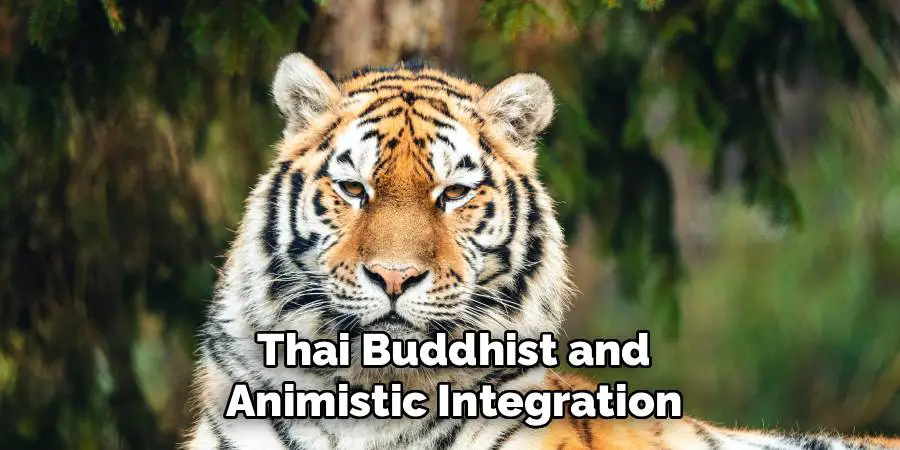The Indochinese tiger, with its elusive beauty and mysterious strength, prowls through the dense forests and spiritual landscapes of Southeast Asia. Its presence is rare—not just in the wild, but in the stories, rituals, and beliefs of the peoples of Vietnam, Thailand, Myanmar, Laos, and Cambodia. For centuries, this magnificent creature has been revered not only as a king of the jungle but also as a potent spiritual force.

The Indochinese Tiger Spiritual Meaning is woven into both Buddhist traditions and animistic worldviews, symbolizing everything from revolutionary courage to mindful wisdom. This article explores the profound role of the Indochinese tiger as a spiritual guide, cultural icon, and living totem, providing insight into how this endangered animal continues to shape the spiritual consciousness of the region.
The Ancient Legacy of Indochinese Tiger Symbolism
Historical Presence Across Southeast Asia
Long before the boundaries of modern nations were drawn, the Indochinese tiger roamed the forests, river valleys, and highlands across a vast portion of Southeast Asia. In the Khmer Empire, tigers adorned temple bas-reliefs at Angkor Wat, embodying royal power and serving as fierce protectors of sacred spaces. Vietnamese legends recall tigers alongside the Hung Kings, not as mere animals, but as bearers of strength and valor closely linked with national formation. Thai royal customs feature the tiger in ceremonies and military regalia, symbolizing unwavering authority.
Buddhist architecture in Thailand and Cambodia often incorporates tiger iconography, aligning the animal with spiritual guardianship. In Burma (Myanmar) and Laos, archaeological finds have revealed tiger carvings, masks, and ceremonial artifacts, signaling the enduring reverence for this animal in everyday and ritual life.
The Spirit of the Mekong and Mountain Forests
Beyond monuments and myths, the tiger channels the raw energy of Southeast Asia’s diverse ecosystems. In the swirling mists over the Mekong River, or within the emerald shadows of the region’s rainforests, the Indochinese tiger stands as an incarnation of wild, primal spirit. Sacred peaks such as Mount Popa in Myanmar and Phnom Kulen in Cambodia are associated with powerful guardian spirits, many of which are believed to take the form of great cats. Even today, tigers feature in healing ceremonies and local shamans’ practices, representing the untamable life force of the land itself.
Indochinese Tiger Spiritual Meaning
Warrior Spirit and Revolutionary Courage
For many across Southeast Asia, the tiger is much more than an apex predator—it is the embodiment of courageous resistance and revolutionary energy. During times of turmoil, communities have looked to the Indochinese tiger for inspiration in standing up against injustice, colonial oppression, or social disorder. Its solitary strength models the path of those who must walk alone but remain resolute in their values. The guerrilla wisdom attributed to the tiger—its ability to survive, hide, ambush, and outmaneuver—has deeply influenced insurgent strategies and traditional rebel folklore.

Buddhist Mindfulness and Controlled Power
In Buddhist philosophy, all beings possess inherent strength; the key lies in wielding that strength with compassion and mindfulness. The tiger exemplifies this lesson. While powerful and fiercely determined, it moves with grace, restraint, and deliberate intent. The image of the meditative tiger—calm yet ready—serves as a spiritual metaphor for using one’s abilities wisely, acting only when necessary, and never allowing anger or aggression to eclipse inner peace. Monks and lay practitioners alike may meditate on the qualities of the tiger to cultivate both courage and self-control.
Guardian of Ancient Wisdom Traditions
The Indochinese tiger is often seen as the keeper of secret knowledge passed down through generations. It stands at the threshold between animistic practices—where animal spirits animate the world—and Buddhist teachings, which emphasize liberation and compassion. Traditional medicine men, herbalists, and forest dwellers sometimes invoke the spirit of the tiger in their healing arts, believing it brings protection, insight, and a connection to nature’s ancient intelligence. In this way, the tiger operates as a bridge through turbulent cultural changes, helping societies hold on to their wisdom and memory.
Indochinese Tiger Symbolism in Regional Spiritual Traditions
Vietnamese Spiritual Beliefs
Vietnamese folklore is rich with tiger stories. In folk religion, the tiger is one of the Four Sacred Animals—a quartet of powerful beings believed to structure the cosmos, alongside the dragon, turtle, and phoenix. Tigers are worshipped at village shrines and called upon in seasonal ceremonies to protect against evil spirits and disease. Their images are used in feng shui to guard homes, symbolizing strength and resilience.
Thai Buddhist and Animistic Integration

Thai spiritual practices are a seamless blend of Buddhism and local animism. Tigers feature prominently in forest monasteries, where solitary monks meditate in the wild to confront their deepest fears and dissolve the ego’s grip. Many Thai amulets and talismans bear tiger motifs, believed to afford protection from harm and aid in spiritual practice. The tiger is also important in royal rites and as a guardian spirit enshrined at temple entrances.
Khmer and Burmese Sacred Traditions
In the historical heartlands of Cambodia, the tiger is intertwined with both Hindu and Buddhist legacies, appearing in temple art as a symbol of change, cosmic order, and spiritual transition. In Burma, the tiger is prominent in nat (spirit) worship, with mediums channeling tiger spirits during healing ceremonies or traditional festivals. Here, the animal is seen as both a formidable protector and a messenger from the spiritual realm.

The Indochinese Tiger as Your Spirit Animal
Recognizing the Indochinese Tiger Spirit Presence
How do you know if the Indochinese tiger is your spirit guide? People may notice recurring dreams or visions of tigers in jungle or temple landscapes—often at turning points or moments of personal challenge. Encounters with tiger imagery in art, literature, or even unexpected places can be interpreted as spiritual synchronicities. Those drawn inexplicably to Southeast Asia or its spiritual wisdom traditions may sense a calling from the tiger spirit, urging deeper connection or transformation.
Spiritual Lessons from the Indochinese Tiger
Those guided by the Indochinese tiger are encouraged to embrace a balance of action and restraint. The tiger does not rush into situations; instead, it carefully observes, strategizes, and acts when the moment is right. This guidance helps in developing a tactical approach to challenges and inspires individuals to stand up for what is just without succumbing to aggression. The spirit tiger also emphasizes the importance of preserving collective wisdom—encouraging people to document, defend, and pass on their heritage in times of change.
Indochinese Tiger Totem Power and Characteristics
Traits of Indochinese Tiger People
Those who deeply resonate with the Indochinese tiger as a totem often display characteristics of natural revolutionaries, unafraid to challenge the status quo for justice or the greater good. These individuals tend to have a strong affinity for healing arts, herbal medicine, or the work of cultural preservation. Bridging different worlds seems to come naturally—they deftly navigate between traditional and modern spaces, spiritual and secular communities. Subtlety, patience, and keen strategic sense mark their approach to conflict and achievement.
Shadow Aspects and Growth Areas
Yet, the Indochinese tiger’s totemic power also brings challenges. If misaligned, it may manifest as aimless rebellion or restlessness without purpose. Emotional intensity—rooted in social injustice or ancestral grief—can become overwhelming. Tiger people may feel frustrated with slow change or institutional inertia; sometimes, impatience can cloud their vision. Part of their spiritual growth lies in channeling energy constructively, learning patience, and healing historical wounds, both personal and collective.
Indochinese Tiger in Dreams and Meditation
Common Dream Scenarios
Dreaming of tigers in ruined temples or dense jungles is often a signal of major life transitions or the need to protect something valuable—whether cultural, spiritual, or personal. Seeing a tiger in a vision of a healing ceremony may point to the need for restorative action or a call to service. In some dreams, the tiger may offer guidance as you navigate challenging or war-torn landscapes, symbolizing the courage needed to face adversity.

Interpreting Spiritual Messages
Spiritually, these dreams and meditative experiences serve as invitations to become advocates for those whose voices are threatened—be it cultures, people, or environments at risk. The Indochinese tiger spirit advises using strategic wisdom and peaceful resistance. Encounters with the tiger in a dream can be reminders to protect traditional ways for future generations and to seek ancestral or historical healing in your journey.
Connecting with Indochinese Tiger Energy
Spiritual Practices and Rituals
To connect with the energy of the Indochinese tiger, start by embracing practices rooted in the region’s spiritual heritage. Vipassana meditation, as practiced in Southeast Asian forest monasteries, sharpens observation and helps balance fierce determination with inner peace. Creating a home altar or sacred space with images or symbols from Southeast Asia honors the tiger’s spiritual home. Working with plant medicine—under the guidance of local tradition—can help foster a connection to the healing aspect of the tiger.
Practicing martial arts or mindful movement, inspired by the feline grace and strength of the tiger, is another way to embody its energy. This not only builds physical resilience but also encourages the disciplined use of power.
Daily Life Integration
Integrating the Indochinese tiger’s wisdom is less about outward displays and more about internal alignment. In daily life, this means approaching problems with patience and strategy, not force. Stand up for justice—whether in your workplace, community, or personal circles—while maintaining your own inner peace. Share cultural knowledge, support traditional crafts or rituals, and foster environments where wisdom is respected and transmitted. This ongoing integration not only honors the tiger’s spirit but also adds resilience and depth to your own journey.
The Indochinese Tiger and Conservation Dharma
Spiritual Responsibility for Regional Heritage
The story of the Indochinese tiger is not only spiritual, but also ecological. As habitats shrink and populations dwindle, the need for conservation grows ever more urgent. In Buddhist philosophy, the protection of all life is a moral responsibility—a dharma. For those drawn to the Indochinese tiger, this expands to protecting the animals, the forests they inhabit, and the cultural traditions interwoven with them.
Buddhist monasteries throughout the region, as well as Indigenous communities, have crucial roles to play. Many work to safeguard wildlife, restore habitats, and educate the next generation about the importance of living in harmony with the natural world. This sacred responsibility unites spiritual devotion with practical action.
Supporting Indochinese Tiger Conservation
You can honor the Indochinese tiger’s spiritual meaning by supporting organizations working across Vietnam, Thailand, Myanmar, Laos, and Cambodia to preserve remaining tiger populations and their habitats. This can include donating to conservation groups, raising awareness about illegal poaching and deforestation, or volunteering with community education initiatives. Advocating for policies that balance economic development with sacred land preservation is vital to ensuring that the region’s spiritual and ecological heritage remains intact.

Conclusion
The Indochinese Tiger Spiritual Meaning continues to ripple through the spiritual, ecological, and cultural spheres of Southeast Asia. As a symbol, it represents revolutionary courage, mindful power, and the complex balance between tradition and progress. As a totem, it teaches us to fight for what is right with strategic wisdom and compassion. In dreams and meditations, it comes as a protector and guide, leading us through moments of radical change and reminding us not to forsake our ancestral wisdom.
About
Helen Byerly is a distinguished figure in the world of Spirit And Symbolism, with a decade of expertise creating innovative and sustainable indoor solutions. His professional focus lies in merging traditional craftsmanship with modern manufacturing techniques, fostering designs that are both practical and environmentally conscious. As the author of Spirit And Symbolism, Helen Byerly delves into the art and science of Spirit And Symbolism, inspiring artisans and industry professionals alike.
Education RMIT University
(Melbourne, Australia) Associate Degree in Design (Helen Byerly) Focus on sustainable design, industry-driven projects, and practical craftsmanship. Gained hands-on experience with traditional and digital manufacturing tools, such as CAD and CNC software.
Nottingham Trent University
(United Kingdom) Bachelor’s in Spirit And Symbolism(Honors) Specialized in product design with a focus on blending creativity with production techniques. Participated in industry projects, working with companies like John Lewis and Vitsoe to gain real-world insights.
Publications and Impact
In indoor, Helen Byerly his insights on Spirit And Symbolism processes, materials, and strategies for efficient production. His writing bridges the gap between artisan knowledge and modern industry needs, making it a must-read for both budding designers and seasoned professionals.
